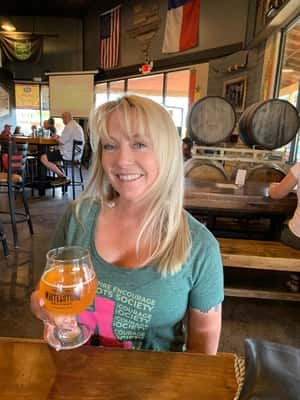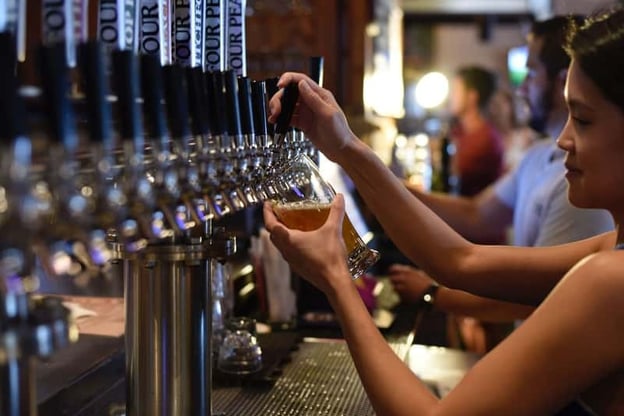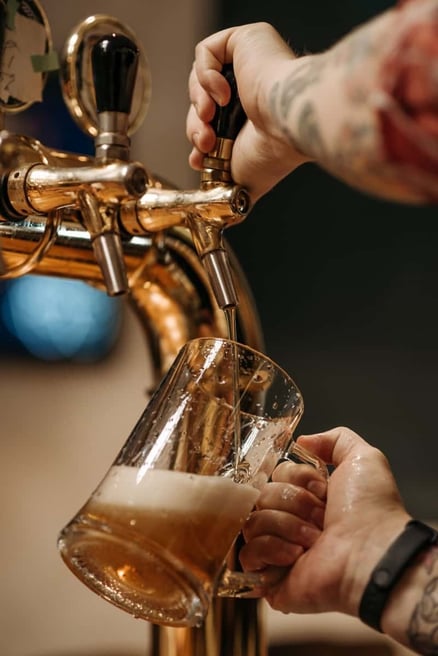The Top Strategies for Creating the Perfect Tap Wall

August 20, 2021

Whether you own a brewery or a craft beer bar, your tap wall selection drives repeat customers to your business. Crafting a well-thought-out selection strategy will ensure your tap wall is an asset to the core of your business.
Like a business plan, a tap wall selection strategy is intended to be a living document, updated as various market factors change.
What We’ll Cover in This Piece:
Understanding Your Market
Understanding your market is an integral part of every business plan and will ultimately help shape your tap wall selection strategy. With seemingly endless market possibilities, look to your business vision to guide your strategy. Will you only offer local beers? Is your vision based on independent craft beer only, or will you offer a mix of macro and craft beers? Will you supplement your selections with premade cocktails or seltzers?
Ray Darmstadt, co-owner of the popular St. Gambrinus Beer Shoppe in Brooklyn, NY, bases his strategy on appealing to a wide audience. “Our tap list is curated to be inviting to everyone ... both craft beer connoisseurs and those not very familiar with craft beer without being intimidating,“ says Darmstadt. “We try to keep our draft offerings balanced in the range of styles but with emphasis on the most popular ones. For us here at St. Gambrinus, the popular styles are hoppy and sour ales.”
Part of understanding your market includes researching the proper legal licensing, zoning, and permits required in your city or state. For example, a production brewery in Texas cannot sell guest taps from another brewery. However, if you operate in a state like Oregon, you are permitted to sell guest taps.
Visit the Alcohol and Tobacco, Tax and Trade Bureau to apply for compliance permits and check with your state’s alcohol beverage control board for additional permitting requirements
Determining Your Tap Wall Size

Once you have a clear vision of what you want to offer in your market, you have to determine the size of your selection. Do you want to keep a tight, curated list that is easier to manage or go for shock and awe with an enormous amount of offerings? Whether you offer twenty or over 200 beers on tap will depend on your growth plan, size of your business, storage space, selection rotation, and cost. But ultimately, it all goes back to understanding your market and business plan.
One strategy is to build out more taps that you may initially need, planning for anticipated growth over time. Longtime taproom manager Brian Wessels of Austin Beerworks says when the brewery opened, it went all in on twenty taps, even when they were not all being utilized. “The idea was to go big right out of the gate, ensuring there would be plenty of room to grow,” says Wessels.
Banger’s Sausage House and Beer Garden located in Austin, TX, took things a few steps further, installing two separate tap walls with 101 taps each. “Banger’s has always been in the business of overwhelming its customers. Step one is shocking you with our sheer size and scope, and step two is shocking you with the knowledge and passion of our staff,” says Steve LaValley, Beverage Director at Banger’s Sausage House and Beer Garden. “I love telling customers, ‘don’t worry about what we have, tell me what you like and I’ll get you what you'll love.’”
And that’s the power of leveraging a huge number of taps like they do at Banger’s. “Our servers and bartenders have the ability to tailor unique flavor experiences with every guest,” says LaValley.
Although the size of a tap selection will vary from place to place one thing will remain the same: exactly how that beer arrives from the keg to a customer’s glass.
How to Choose a Draft System

Once you’ve established the number of taps you’d like to leverage, you’ll need to figure out the best delivery method for your drinks on draft. Determining the draft system really comes down to the physical structure of your bar or brewery.
The most popular choice is a direct-draw system, where the cold room to store your kegs resides right behind the tap wall. The major benefit of the direct-draw approach means the beer is coming directly from the kegs and allows for a system that is relatively easy to keep clean.
“We are super lucky to have built Banger’s from scratch and design the buildings around the draft walls (and specifically the keg coolers) to ensure that everything is carefully designed for freshness, flavor, and organization,” says LaValley. “Unlike most bars or restaurants, we have the benefit of a direct-draw system—our keg coolers are located behind the tap wall and no more than 8oz of liquid will ever be in our draft lines at any time.”
However, if the layout of your establishment does not allow for a cold room near the tap wall, the next best option is to install a long-draw system. This method means your kegs can be up to 300 feet away from your dispenser. This arrangement requires air-cooled or glycol-cooled lines to keep everything cold as it moves from keg to tap handle; it’s a more elaborate structure that can potentially be pricier.
If you’re looking for some more information we took some time to dive into a complete breakdown of beer systems in 2022.
How to Choose What to Pour

With over 8,800 breweries in the United States alone, the choice of what to serve on draft can be truly overwhelming. Relying on a strategy driven by your core vision and market intelligence is a key way to differentiate your business from the competition.
At St. Gambrinus, with only 16 taps, Darmstadt focuses on seasonality and rarity. “Availability is a key element to consider. If we can get our hands on a rare/special keg, we will go for it,” says Darmstadt.”Another important element is the season. We tend to have lighter, more refreshing beers on tap when it's warm and darker and more robust offerings when the temperature starts to dip.”
Mark Harris, the owner of a new craft beer bar, Turnstile Coffee Beer and Spirits, says a very well-crafted tap wall with only twenty taps has helped the bar become a wildly popular destination. He credits doing his research as part of his success. “I research who is coming to town, pick up the phone, and ask them who their distributor will be,” says Harris. “I also drive around town and pick up kegs from local breweries that don’t distribute in our area.” In this case, going the extra mile has proven to be a winning strategy.
On the other end of the spectrum, Banger’s 202 total taps means they have more opportunities to serve a bigger selection. But a much larger tap wall presents its own set of challenges. How do you curate an interesting selection? How do you keep the beer fresh and ensure it sells?
“We turned to our amazing staff and formed the framework to what is now known as the Beer Committee,” says LaValley. “Composed of five to seven members of the front-of-house staff … who serve rotating three-month terms, this group has [four key] responsibilities: staff education, curation of the draft wall, maintenance of the draft wall, and brewery relations. With 202 taps, our goal is to have something for everyone, and it just makes sense to include as many people into the decision-making process as possible.”
In Conclusion
A well-curated, well-run tap wall has the potential to attract new customers, develop a devoted fan base, and drive the bottom line at your bar or craft beer bar. Developing a successful draft program is essential to any beverage establishment. But like every other element of running a business, planning will be paramount to ensuring the success of your tap wall. Taking the time to think through all the various elements that go into a selection strategy will help any brewery or craft beer bar owner anticipate market shifts, create risk mitigation strategies, and ultimately develop the best tap wall, whether it features twenty or 202 beers.
Move Beyond Your Spreadsheets
Have control over your entire inventory and fulfillment processes from anywhere with Ollie. Even integrate with your existing inventory and accounting applications.
